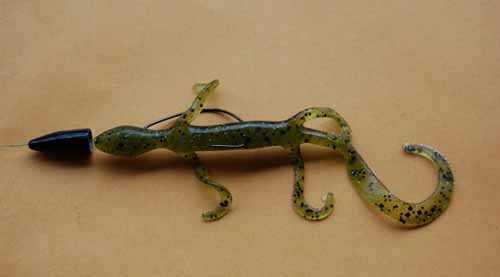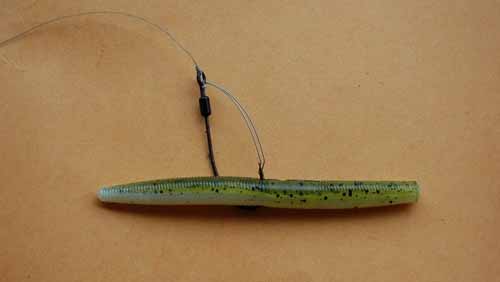Search
Latest Articles
Rigging Worms for Bass
by Ben Team for AnglersClub.com, May 03, 2016
They may not be the most popular lures among tournament pros, and they aren’t as trendy as swimbaits (which are arguably a type of soft plastic bait) or umbrella rigs are; but anglers will continue to cast plastic worms into lakes and rivers for as long as bass live in them – and they will continue to catch fish while doing so.
There are a million reasons to love soft plastic worms, but one of the key strengths of these lures is that they can be rigged in a variety of Some rigging styles lend themselves to the kind of finesse techniques anglers use to catch lethargic, finicky bass in ultra-high-pressured ponds, while others are useful for covering lots of water, while picking off one aggressive bass after another.

With that, let’s start to examine some of the common rigging techniques, beginning with the two classics.
Texas Rigging
The Texas rig is probably the best-known method for rigging plastic worms or lizard, and it provides a great way to keep your bait down at the bottom. When rigged in weedless fashion, Texas-rigs are one of the best techniques for fishing heavy cover.
To whip up a Texas rig, begin by threading a 1/8- to 1-ounce nose weight onto your line (or a leader if you so desire). Then tie an offset hook to the line with an improved clinch or Palomar knot. If you like, you can “peg” the weight to the hook by jamming a toothpick through the eye of the weight and breaking it off – this will keep the weight from sliding up and down the line.
Insert the point of the hook into the head of the bait. Slide the bait onto the hook until you arrive at the bend; at this point, allow the hook tip to emerge from the side of the bait. Keep pushing the bait onto the hook until it reaches the eye. Then, take the hook and turn it 180 degrees on its axis. Insert the hook back into the worm until it barely protrudes from the opposite side of the worm’s body.
Rigs are sometimes called “Texposed” this way – to make it truly Texas-rigged, you need to bury the very tippy tip of the hook back in the worm’s body. This keeps the rig relatively weedless, but it necessitates a stronger hookset.
Carolina Rigging
You have to catch a fish’s attention first to have a chance a catching the fish, and the Carolina rig uses both visual and mechanical stimuli to help attract bass.
To make a Carolina rig, thread a ¾- to 2-ounce sinker onto your line, followed by a plastic (not glass) bead. Th en, tie a swivel onto the end of your main line. Attach an 18- to 60-inch leader (the clearer the water, the longer the leader) to the opposite end of the swivel, and tie an offset hook to the other end of the leader. Place a plastic lizard or worm on the hook as you would when Texas rigging.
The idea behind the Carolina rig is that the weight and bead create a ruckus as you drag it along the bottom (the bead also protects your knot from the weight). Mr. Bass then swims over to see what the hubbub is all about, notices the delicious looking meal darting around just a few feet away and smashes it.
Although diagrams of Carolina rigs often display the bait floating several inches off the bottom, this is not what happens in practice. The bait stays pretty close to the bottom unless you use a floating bait or add a small float right in front of the bait.
Jig Heads and Shaky Heads
Jig heads and shaky heads allow anglers to achieve a Texas-style rig, in the convenience of a one-piece package. At its core, a jig head is simply a worm hook with a molded lead weight poured around the hook shank. Some are simple, round lead balls, while others feature realistic (or obnoxious) paint jobs.

You use either the same way you would a regular hook, by threading the tip of the hook into the end of the bait. Push the worm up until you reach the hook’s bend, and let the point emerge from the plastic bait. Spin the hook around and stick the hook back into the bait, letting it emerge from the other side. Tuck the tip back into the worm’s body and you are ready to fish the gnarliest cover without fear of snags (mostly).
Alternatively, you can simply thread the plastic bait onto the hook and allow the point to emerge from the side of the bait’s body. Leaving the hook exposed in this way means that the lure will snag more often, but it also makes hooksets easier. Let the cover you’re fishing dictate your choice.
The primary difference between a regular jig head and a shaky head is that a shaky head is designed to stand up on the bottom, making your bait imitate a small fish feeding on the bottom. You can use just about any plastic bait you like with either head, but grubs and plastic minnows are probably among the most popular choices.
Wacky Rigging
I resisted wacky-rigging for a long time; it just felt like a completely unnatural way to present a bait. Most aquatic creatures move in a serpentine-like manner, and I cannot think of any pond- or lake-dwelling animal that flaps both ends of its body like a pair of wings to get around.

But then I tried it, and it didn’t matter how unnatural it felt – it just works. In fact, it is one of the best baits for getting stubborn fish to give in and take a chomp. Besides, after thinking about it for a long time, it occurred to me that while healthy aquatic critters don’t move in a serpentine fashion, wounded fish do flop about like that on occasion.
Wacky rigging is ridiculously simple: take the hook and jam in through the middle of the bait. Snags can be a bit of a problem with this rigging style, but you can downsize your hook or use hooks with weed guards to help keep your bait flapping freely.
Stick baits, French fries and finesse worms are some of the most popular plastics to rig in this manner.
Neko Rigging
Neko rigs are essentially a variation on the wacky rig.
Usually performed when using plastic stick baits like Senkos, Dingers or generic versions thereof, Neko rigs rely on a weight inserted into one side of the worm to increase the lure’s rate of fall and make it behave like a deranged and vulnerable prey item. To rig up a worm Neko-style, simply wacky rig it and then jam a nail, screw or worm weight into one end. Easy-peasy.
Drop Shotting
Drop shot rigs are great for putting a bait in front of a bass’ nose, and keeping it there until she nails it.
Setting up a drop shot rig is fairly straightforward. Start by tying a 1/8- to ½-ounce drop shot weight to the end of your line. At the desired distance from the weight, tie a small hook onto your line using a drop shot knot. You can hook up the bait Texas-style or you can nose hook it – both strategies work, although nose hooking allows the bait to flutter really well. Finesse worms, flukes and stick baits are some of the most popular choices for drop shot rigs, but feel free to experiment – just about anything will work.
-2.jpg)



